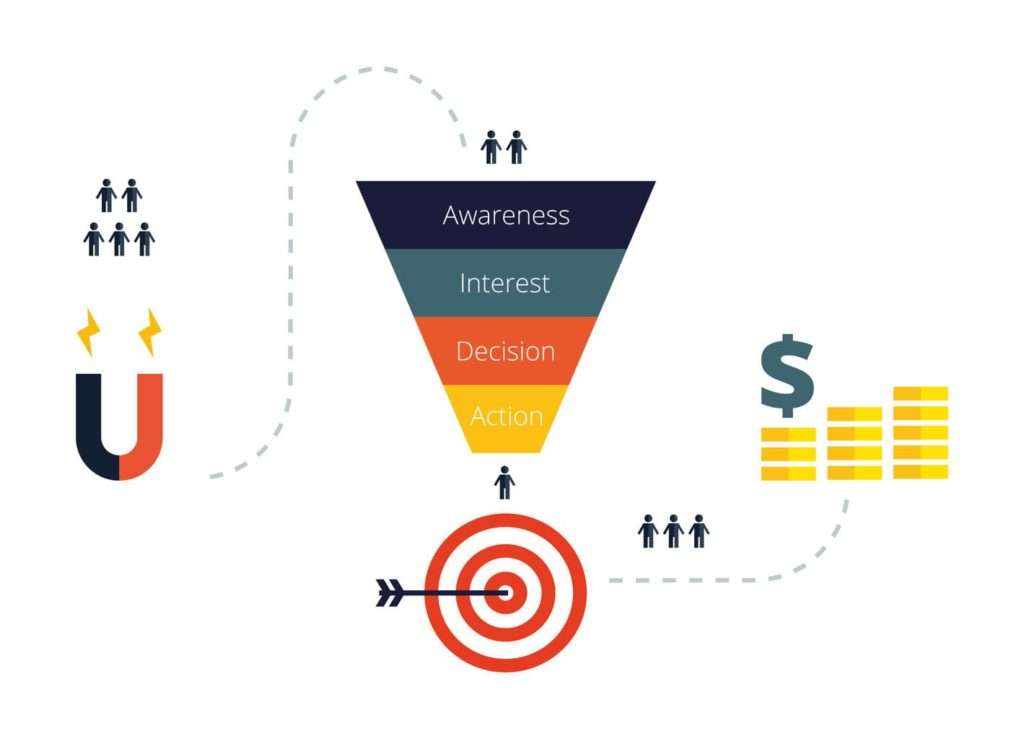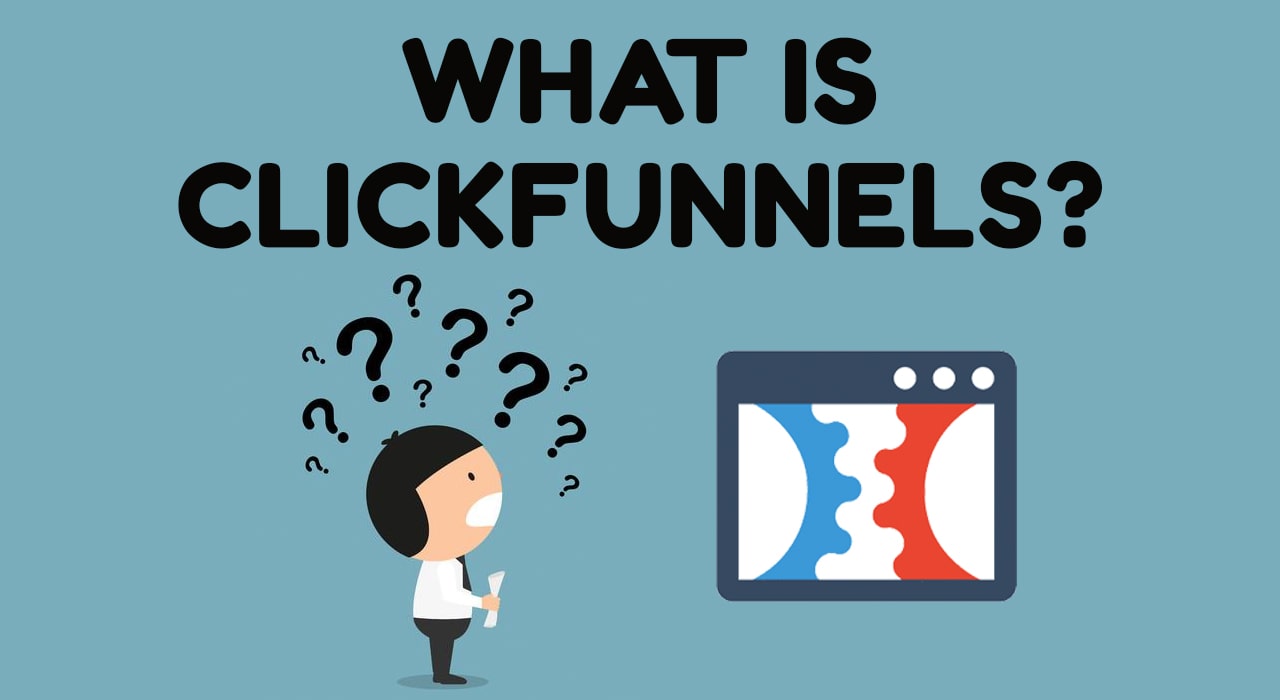Today we are going to talk about what is a sales funnel and why they matter. We’ll also cover how you can start building your own sales funnel from scratch.
Everyone’s heard about sales funnels, but it seems like there are still a lot of people that don’t get it. I’ve always found that the best way to help people understand something is to show them examples of how others are using funnels in their business, and then I can share my personal strategies as well.
Without further ado, let’s explore what a sales funnel is and how you can build one to increase conversions and drive sales for your business.
Table of Contents
What is a sales funnel?
A sales funnel, also known as a revenue funnel or sales process, is a visual representation of the steps a potential customer goes through when making a purchase from a business. It is a model that describes the customer journey from initial awareness of a product or service to the actual purchase.
The sales funnel typically includes several stages, such as awareness, interest, consideration, and decision, and each stage requires a different marketing approach to move the customer closer to the final purchase.
By understanding the sales funnel and optimizing it, businesses can increase their sales and revenue by effectively guiding potential customers through the buying process.
Why do sales funnels matter?
Sales funnels matter because they can help businesses improve their overall sales and revenue. By guiding potential customers through a series of stages that ultimately lead to a purchase, sales funnels can increase the chances of converting leads into paying customers.
Sales funnels also provide a framework for businesses to analyze and optimize their sales process, identifying areas for improvement and making adjustments to increase conversions. In addition, sales funnels can help businesses build stronger relationships with their customers by providing valuable information and personalized experiences throughout the buying journey.
Overall, a well-designed and executed sales funnel can be a powerful tool for businesses looking to improve their sales performance and grow their bottom line.
How to use sales funnels in your business
To get started with funnels in your own business, let’s go over some of the basics. There are 5 main steps involved in any effective sales funnel, and they’re the same no matter what business you’re trying to attract.

Step 1: Define your target audience
Defining your target audience is the first step in creating a successful sales funnel. You need to understand your audience’s demographics, interests, and pain points so that you can create a customized marketing message that speaks directly to them. Here are some steps to defining your target audience:
- Conduct market research: Research your industry and target audience to get a better understanding of their preferences, behaviors, and needs.
- Identify your ideal customer: Create a detailed profile of your ideal customer based on demographics, psychographics, and behavior.
- Craft a customer avatar: Create a fictional character that embodies your ideal customer’s traits and behaviors.
Step2: Create an irresistible offer
Once you’ve defined your target audience, you need to create an irresistible offer that will capture their attention and entice them to take action. Here are some steps to creating an irresistible offer:
- Identify your target audience’s pain points: Understand your target audience’s challenges and create an offer that addresses those challenges.
- Create a unique value proposition: Highlight the unique benefits of your offer and what sets it apart from your competitors.
- Choose a compelling offer format: Determine the format of your offer, such as a free trial, eBook, webinar, or discount.
- Set clear expectations: Clearly communicate what your offer includes, how it works, and what the customer can expect from it.
By focusing on these key elements, you can create an offer that is truly irresistible to your target audience and increase your chances of conversion.
Step 3: Create your landing page
Creating a landing page is a crucial step in building a successful sales funnel. A landing page is where visitors are directed after clicking on an advertisement or link, and it’s designed to convert them into customers by providing them with a compelling offer and convincing them to take action.
There are several landing page builders available in the market, but ClickFunnels is widely considered the best. Here are some reasons why ClickFunnels is the best landing page builder:
- User-Friendly Interface: ClickFunnels has an intuitive drag-and-drop interface that makes it easy for users to build landing pages without any coding knowledge.
- Customizable Templates: ClickFunnels offers a variety of customizable templates that can be tailored to fit your brand and goals.
- A/B Testing: ClickFunnels allows you to test different landing page variations to see which one performs best.
- Integrations: ClickFunnels integrates with a variety of third-party tools, such as email marketing services and payment gateways.
- Analytics: ClickFunnels provides detailed analytics to help you track the performance of your landing pages and sales funnels.
ClickFunnels is a popular landing page builder that allows businesses to create landing pages quickly and easily. Here’s a quick guide on how to create a landing page using ClickFunnels:
- Sign up for ClickFunnels: To get started, you need to sign up for ClickFunnels. You can choose from a variety of pricing plans depending on your needs and budget.
- Choose a landing page template: ClickFunnels offers a wide variety of landing page templates that you can choose from. These templates are designed to be customizable, so you can add your own branding, content, and images.
- Customize the landing page: Once you’ve chosen a landing page template, you can start customizing it. ClickFunnels has a drag-and-drop editor that allows you to easily add and rearrange elements on the page. You can add text, images, videos, forms, and more.
- Set up your funnel: A funnel is a series of pages that lead visitors toward a specific goal, such as a sale or a sign-up. With ClickFunnels, you can create a funnel by adding multiple pages to your landing page. You can also set up email sequences, order bumps, and upsells to increase conversions.
- Publish your landing page: Once you’re happy with your landing page, you can publish it. ClickFunnels allows you to publish your landing page on your own domain or on a ClickFunnels subdomain. You can also integrate your landing page with other marketing tools such as email marketing services, payment processors, and analytics tools.
- Test and optimize your landing page: After your landing page is live, it’s important to test it and optimize it for better performance. ClickFunnels has built-in analytics that allows you to track the performance of your landing page and make changes to improve its effectiveness.
4. Create a lead magnet
Creating a lead magnet is an effective way to attract potential customers to your sales funnel. A lead magnet is an incentive or offers that you provide to your target audience in exchange for their contact information, such as their email address. It could be anything from an eBook, checklist, video tutorial, or a free trial of your product or service.
5. Use email marketing
Once you have their contact information, you can use email marketing to further nurture the relationship with your leads. This means sending them relevant and valuable content that helps address their needs and pain points. You can also use email marketing to offer them additional products or services that could benefit them.
6. Use retargeting ads
Retargeting ads are another effective way to bring back leads who didn’t convert on your landing page. By using a pixel or code on your website, you can track visitors and show them personalized ads on other websites or social media platforms. These ads can remind them of your product or service and encourage them to come back to your landing page to complete their purchase or opt-in.
7. Measure and optimize
Measuring and optimizing your sales funnel is crucial to ensure that you’re getting the most out of your efforts. This means tracking metrics such as conversion rates, click-through rates, and bounce rates to see how your landing page, lead magnet, email marketing, and retargeting ads are performing. By analyzing these metrics, you can identify areas for improvement and make changes to optimize your sales funnel for better results.
The bottom line
Building and utilizing a sales funnel can be a crucial aspect of growing and scaling your business. By creating a clear path for potential customers to follow, you can increase conversions and ultimately generate more revenue.
Remember to focus on creating a strong lead magnet, implementing email marketing and retargeting ads, and continuously measuring and optimizing your funnel for the best results.
With the right tools and strategies, such as using ClickFunnels as your landing page builder, you can create a highly effective sales funnel that drives your business forward. So take the time to build and refine your funnel, and watch as it helps you reach new levels of success.







